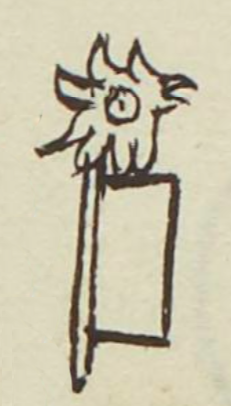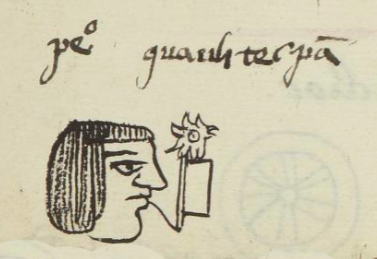Cuauhtecpan (MH593r)
This black-line drawing of the compound glyph for the personal name Cuauhtecpan (“Wooden Bars” or "Wooden Trellis," attested here as a man’s name) shows an eagle's head in profile, facing toward the viewer's right. The eagle's visible eye is open, as is its beak. The feathers on its neck and on the top of its head are spiky. The eagle's head provides the phonetic indicator for "wooden" (cuauh-) in this case. Below that is an upright, rectangular banner, seemingly the banner that represents the number twenty (tecpantli or refers to things in a row. This is another phonetic indicator.
Stephanie Wood
The "tecpan" could be short for the verb, tecpana, to put things in a row. Or, it could be the noun, tecpantli, a group of twenty. Because names that comprise other verbs (such as paina) can drop the final vowel, it would seem this name could draw from either a noun or a verb, with slightly different meanings. Eagles are associated with warriors.
Stephanie Wood
peo guauhtecpā
Pedro Cuauhtecpan
Stephanie Wood
1560
Jeff Haskett-Wood
animales, banderas, números, veinte, águilas, nombres de hombres, rejas de madera, feathers, plumas

cuauh(tli), eagle, https://nahuatl.wired-humanities.org/content/cuauhtli
tecpana, to put in order, https://nahuatl.wired-humanities.org/content/tecpana
tecpan(tli), twenty, https://nahuatl.wired-humanities.org/content/tecpantli
pan(itl), flag or banner, https://nahuatl.wired-humanities.org/content/panitl
Veinte Águilas o Águilas en Fila
Stephanie Wood
Matrícula de Huexotzinco, folio 593r, https://www.loc.gov/resource/gdcwdl.wdl_15282/?sp=265&st=image
This manuscript is hosted by the Library of Congress and the World Digital Library; used here with the Creative Commons, “Attribution-NonCommercial-ShareAlike 3.0 License” (CC-BY-NC-SAq 3.0).




